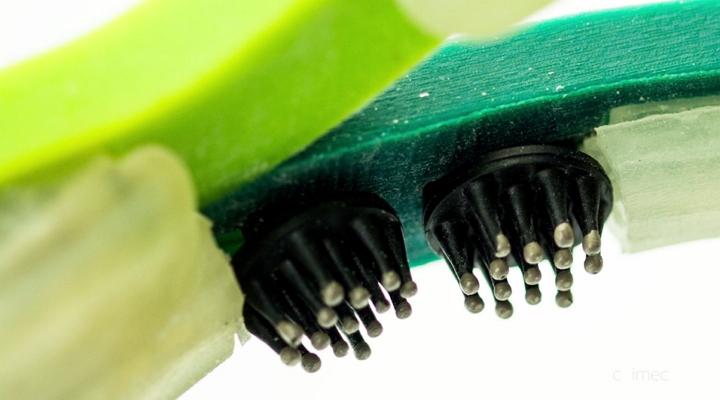 Imec, the Holst Centre and The Netherlands Organization for Applied Scientific Research, along with the Industrial Design Engineering faculty of Delft University of Technology, have introduced a wireless electroencephalogram – or EEG – headset that is both comfortable and delivers a high-quality signal.
Imec, the Holst Centre and The Netherlands Organization for Applied Scientific Research, along with the Industrial Design Engineering faculty of Delft University of Technology, have introduced a wireless electroencephalogram – or EEG – headset that is both comfortable and delivers a high-quality signal.
The novel headset makes possible brain-computer interfacing, and it can even monitor a user’s emotions and moods via an associated smartphone application.
Imec and Holst Centre say this technology bridges consumer applications and healthcare monitoring wearables with “medical-grade data acquisition.”
Imec is involved in research in nanoelectronics, and the company leverages scientific knowledge and global partnerships in ICT, healthcare and energy to deliver technology solutions for industry. Headquartered in Leuven, Belgium, imec operates offices in Belgium, the Netherlands, Taiwan, the USA, China, India and Japan. With a staff of some 2,200 people, that number includes nearly 700 industrial “residents” and guest researchers.
The wireless EEG headsets use dry electrodes and can be used in consumer applications such as games that monitor relaxation, engagement and concentration, and its makers say the headsets can also be used for applications such as sleep training and treating ADHD (Attention Deficit Hyperactivity Disorder).
“Leveraging imec’s strong background in EEG sensing, dry polymer and active electrodes, miniaturized and low-power data acquisition, and low-power wireless interfaces to smartphones, we were able to focus on the ergonomics of this project,” says Bernard Grundlehner, the EEG system architect at imec.
The design of the wireless EEG headset and the dry electrode system presented a number of technical challenges. Among them, there was a requirement to find a balance between comfort and signal quality. To make sure the signal quality is optimal, the dry electrodes must be applied to the user’s head with sufficient pressure. The developers say contact is critical as measurements are done over longer periods of time.
The headphones use adaptive filter in and band-pass filtering to create an EEG signal from which any impedance and distortion caused by motion artifacts can be removed.
“The correlation between the motion artifacts and the impedance signal is very high, and we have successfully used this impedance signal to reduce the amplitude of the motion artifacts in the EEG signal,” Grundlehner says.“We are using standard Bluetooth and Bluetooth low-energy radio technology, which when combined with a very sensitive EEG amplifier can be very challenging. The radiated radio frequency power can be easily picked up by the system resulting in noise spikes in the spectrum of the EEG signal.”
The design procedure resulted in a series of shape and stiffness prototypes and tested them repeatedly in very short loops as a team of six master students from the faculty IDE of TU Delft worked on the challenge as part of their Advanced Embodiment Design project.
 And to simplify the manufacturing process, the EEG headsets are built in one piece with 3D printing techniques, as Grundlehner explains in a video (below). The process begins after the electronic components are applied, and they are then covered with a 3D printed rubber overlay. Those sensors which acquire the EEG signal are located at the front of the headset to allow optimal EEG signal acquisition.
And to simplify the manufacturing process, the EEG headsets are built in one piece with 3D printing techniques, as Grundlehner explains in a video (below). The process begins after the electronic components are applied, and they are then covered with a 3D printed rubber overlay. Those sensors which acquire the EEG signal are located at the front of the headset to allow optimal EEG signal acquisition.
A mobile app then relates a user’s emotional state by collecting and analyzing environmental information such as location, proximity to others and the time of day. Once that process is complete, the app provides feedback about the unconscious effects of the environment on a user’s emotions.
What do you think of this EEG monitoring headset from imec and Holst Centre? Would you want a set of these 3D printed headphones to monitor your emotional state throughout the day? Let us know in the 3D Printed EEG Headset forum thread on 3DPB.com.
Subscribe to Our Email Newsletter
Stay up-to-date on all the latest news from the 3D printing industry and receive information and offers from third party vendors.
Print Services
Upload your 3D Models and get them printed quickly and efficiently.
You May Also Like
Consolidation in AM: How 2025 Is Shaping the Industry’s New Normal
The first half of 2025 has been marked by a clear shift in the additive manufacturing (AM) industry. Companies are no longer just focused on developing new tech by themselves....
Etsy Design Rule Change Reduces Selection of 3D Printed Goods
Online marketplace Etsy has implemented a rule change requiring all 3D printed goods on the site to be original designs. The update to the site’s Creativity Standards states, ¨Items produced using...
U.S. Congress Calls Out 3D Printing in Proposal for Commercial Reserve Manufacturing Network
Last week, the U.S. House of Representatives’ Appropriations Committee moved the FY 2026 defense bill forward to the House floor. Included in the legislation is a $131 million proposal for...
Transforming From Tourist to Native: Duro CEO Michael Corr Explains Why the Company Rebuilt its PLM Software on AI
In these early innings of the AI boom, many market analysts have expressed concern that AI spend has gotten too far ahead of the technology’s proven ability to deliver significant...

































